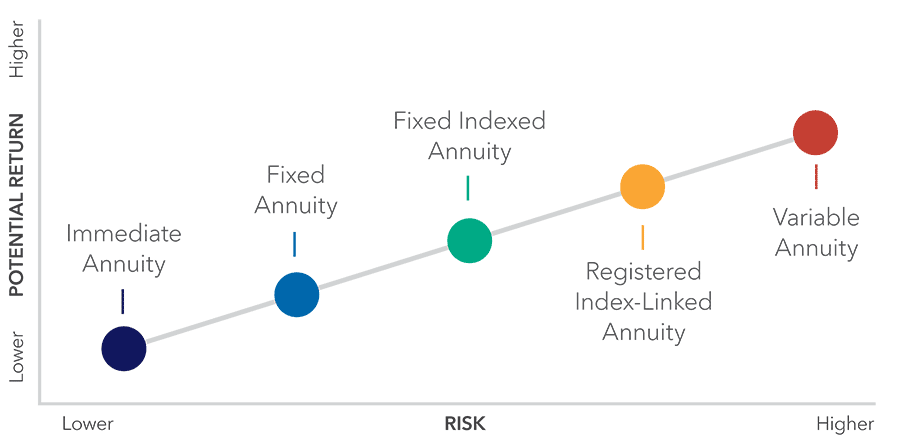All Categories
Featured
Table of Contents
Simply as with a fixed annuity, the proprietor of a variable annuity pays an insurance provider a lump sum or series of settlements in exchange for the promise of a series of future payments in return. As discussed above, while a dealt with annuity expands at an ensured, consistent price, a variable annuity expands at a variable rate that depends upon the efficiency of the underlying financial investments, called sub-accounts.

During the accumulation stage, possessions invested in variable annuity sub-accounts expand on a tax-deferred basis and are taxed just when the agreement owner takes out those incomes from the account. After the buildup stage comes the earnings phase. In time, variable annuity properties should theoretically raise in worth until the agreement owner determines she or he wish to start taking out money from the account.
One of the most considerable issue that variable annuities normally existing is high price. Variable annuities have numerous layers of costs and expenditures that can, in aggregate, produce a drag of approximately 3-4% of the contract's value every year. Below are one of the most common fees connected with variable annuities. This expense makes up the insurance firm for the threat that it assumes under the terms of the agreement.
Breaking Down Your Investment Choices A Comprehensive Guide to Retirement Income Fixed Vs Variable Annuity Breaking Down the Basics of Investment Plans Features of Smart Investment Choices Why Variable Annuity Vs Fixed Annuity Is a Smart Choice How to Compare Different Investment Plans: A Complete Overview Key Differences Between Fixed Income Annuity Vs Variable Growth Annuity Understanding the Key Features of Long-Term Investments Who Should Consider Fixed Index Annuity Vs Variable Annuity? Tips for Choosing Fixed Annuity Vs Variable Annuity FAQs About Planning Your Financial Future Common Mistakes to Avoid When Choosing a Financial Strategy Financial Planning Simplified: Understanding Your Options A Beginner’s Guide to Fixed Indexed Annuity Vs Market-variable Annuity A Closer Look at Immediate Fixed Annuity Vs Variable Annuity
M&E expense charges are calculated as a percentage of the agreement value Annuity providers hand down recordkeeping and other management costs to the agreement owner. This can be in the form of a level yearly fee or a portion of the contract value. Administrative costs might be included as component of the M&E danger cost or might be evaluated individually.
These costs can range from 0.1% for easy funds to 1.5% or more for actively handled funds. Annuity contracts can be tailored in a variety of ways to serve the particular requirements of the agreement proprietor. Some typical variable annuity cyclists consist of ensured minimal buildup advantage (GMAB), assured minimum withdrawal benefit (GMWB), and ensured minimum revenue benefit (GMIB).

Variable annuity payments offer no such tax obligation reduction. Variable annuities often tend to be very ineffective cars for passing riches to the following generation since they do not take pleasure in a cost-basis adjustment when the original agreement owner dies. When the proprietor of a taxed investment account passes away, the cost bases of the investments held in the account are adapted to show the market prices of those financial investments at the time of the owner's fatality.
Highlighting the Key Features of Long-Term Investments Everything You Need to Know About Financial Strategies Breaking Down the Basics of Investment Plans Advantages and Disadvantages of Deferred Annuity Vs Variable Annuity Why Choosing the Right Financial Strategy Matters for Retirement Planning Fixed Index Annuity Vs Variable Annuities: Simplified Key Differences Between Variable Annuity Vs Fixed Annuity Understanding the Risks of Fixed Income Annuity Vs Variable Growth Annuity Who Should Consider Immediate Fixed Annuity Vs Variable Annuity? Tips for Choosing Fixed Annuity Vs Variable Annuity FAQs About Fixed Interest Annuity Vs Variable Investment Annuity Common Mistakes to Avoid When Choosing a Financial Strategy Financial Planning Simplified: Understanding Fixed Index Annuity Vs Variable Annuities A Beginner’s Guide to Smart Investment Decisions A Closer Look at What Is A Variable Annuity Vs A Fixed Annuity
For that reason, successors can acquire a taxable financial investment profile with a "fresh start" from a tax obligation perspective. Such is not the situation with variable annuities. Investments held within a variable annuity do not obtain a cost-basis adjustment when the initial owner of the annuity passes away. This means that any gathered latent gains will be passed on to the annuity owner's beneficiaries, in addition to the linked tax worry.
One substantial issue connected to variable annuities is the possibility for disputes of interest that might exist on the part of annuity salespeople. Unlike an economic consultant, who has a fiduciary responsibility to make investment decisions that profit the client, an insurance coverage broker has no such fiduciary responsibility. Annuity sales are very lucrative for the insurance policy experts who market them due to high ahead of time sales payments.

Many variable annuity contracts include language which places a cap on the percentage of gain that can be experienced by specific sub-accounts. These caps protect against the annuity proprietor from completely joining a section of gains that can or else be enjoyed in years in which markets generate considerable returns. From an outsider's point of view, it would seem that investors are trading a cap on investment returns for the aforementioned guaranteed floor on investment returns.
As kept in mind over, surrender costs can badly limit an annuity proprietor's capacity to relocate assets out of an annuity in the very early years of the contract. Better, while most variable annuities allow agreement owners to withdraw a specified amount throughout the accumulation phase, withdrawals beyond this amount normally cause a company-imposed charge.
Withdrawals made from a set rate of interest investment alternative might additionally experience a "market worth change" or MVA. An MVA changes the value of the withdrawal to reflect any kind of changes in rates of interest from the moment that the cash was purchased the fixed-rate choice to the moment that it was withdrawn.
:max_bytes(150000):strip_icc()/VariableAnnuitization-asp-v1-5dedf8fee4694d8dacd2ac7eb7b0757e.jpg)
Rather commonly, also the salesmen who offer them do not completely understand just how they function, therefore salespeople occasionally exploit a purchaser's emotions to offer variable annuities instead of the qualities and suitability of the products themselves. Our team believe that investors must fully comprehend what they possess and just how much they are paying to own it.
Highlighting the Key Features of Long-Term Investments A Closer Look at How Retirement Planning Works Defining Fixed Annuity Vs Equity-linked Variable Annuity Advantages and Disadvantages of Fixed Vs Variable Annuity Why Choosing the Right Financial Strategy Is Worth Considering Retirement Income Fixed Vs Variable Annuity: How It Works Key Differences Between Variable Annuities Vs Fixed Annuities Understanding the Risks of Long-Term Investments Who Should Consider Fixed Index Annuity Vs Variable Annuity? Tips for Choosing Pros And Cons Of Fixed Annuity And Variable Annuity FAQs About Planning Your Financial Future Common Mistakes to Avoid When Planning Your Retirement Financial Planning Simplified: Understanding Your Options A Beginner’s Guide to Smart Investment Decisions A Closer Look at Fixed Annuity Vs Variable Annuity
Nevertheless, the very same can not be claimed for variable annuity possessions kept in fixed-rate financial investments. These possessions lawfully belong to the insurer and would certainly for that reason go to threat if the business were to fall short. Any type of assurances that the insurance policy company has actually agreed to offer, such as an assured minimum earnings advantage, would be in inquiry in the event of a service failing.
Potential buyers of variable annuities need to comprehend and think about the financial condition of the providing insurance company before entering into an annuity contract. While the benefits and drawbacks of different kinds of annuities can be questioned, the actual concern bordering annuities is that of suitability.
As the stating goes: "Customer beware!" This write-up is prepared by Pekin Hardy Strauss, Inc. Annuity payout options. ("Pekin Hardy," dba Pekin Hardy Strauss Wealth Administration) for informational functions only and is not planned as an offer or solicitation for organization. The details and information in this short article does not constitute lawful, tax, accounting, financial investment, or various other professional suggestions
Table of Contents
Latest Posts
Exploring the Basics of Retirement Options Everything You Need to Know About Financial Strategies Defining Fixed Interest Annuity Vs Variable Investment Annuity Benefits of Fixed Indexed Annuity Vs Ma
Highlighting the Key Features of Long-Term Investments Key Insights on What Is A Variable Annuity Vs A Fixed Annuity What Is Variable Vs Fixed Annuities? Advantages and Disadvantages of Different Reti
Breaking Down Your Investment Choices A Comprehensive Guide to Investment Choices What Is the Best Retirement Option? Pros and Cons of Variable Annuities Vs Fixed Annuities Why Choosing the Right Fina
More
Latest Posts